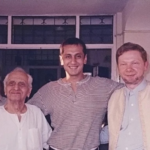April 23, 2018
Samadhis of the Sages

Samadhis of the Sages
Driving along the winding mountain roads in Himachal Pradesh on our way to McLeod Ganj in April 2009, my friends and I visited Swami Chinmayananda’s samadhi at Tapovan. The stillness at the shrine was spine tingling, as was the breathtaking view around it – lush, green foothills against a backdrop of the snow-capped Himalayas. Gabriel, my friend from London, let out a deep sigh and exclaimed, “You’re so lucky! This is one thing that only India, and no other country, has. Samadhis! Only in India!” He was referring to the samadhis of spiritual Masters dotting the length and breadth of India.
This casual remark somehow struck a deep chord within me. For how true, and yet how often overlooked, was this very obvious fact! When I mentioned this to another friend, he asked, “How many samadhis of realised sages are there in India?” I wondered if there was any count of the number of samadhis in the country, and a smile escaped my lips as the answer to that was obvious. Of course there wasn’t, but it would be a number we would be more than happy to have on the higher side, unlike our population census that has crossed the billion mark.
It is rather strange how, more often than not, I had found myself visiting such shrines with like-minded friends. It wasn’t as if I had an intent or wish to visit samadhis – except for a few that really interested me. It was more a case of just going along with friends who were either planning to go there, or we just happened to be in that area and so decided to pay our respects at the samadhi.
Diverse experiences
Over the years, what has really fascinated me has been the experience of different people at the samadhi-shrines of various sages. It was quite interesting to observe how a particular samadhi affected, or rather impacted, each one in a different way. For instance, at a samadhi where all I would sense was a general sense of peace and calm, a friend would say that his Kundalini was going “gang-busters”! At another samadhi, someone would say he was “too drunk on the shakti” and could barely move after experiencing it! Yet another would say that she saw streaks of purple light emanating from the shrine! This almost made me feel I had missed out on an experience. But then I thought that perhaps I was lucky – as the problem with experiences is that they make one hanker for more! And we are aware of the transient nature of experiences – they just come and go. Nevertheless, it was interesting to see this kind of impact upon various people.
Perhaps there was some kind of a link between the energy field of the Master’s samadhi that triggered off something in the energy field of the individual concerned, and this manifested in different ways depending upon the person’s spiritual state. Such a fleeting experience is a ‘happening’ – one that is outside the limits of a rational thought process. To give you an example, my friend Kim wept and laughed uncontrollably without consciously being able to comprehend the reason for her outburst, when she visited Meher Baba’s samadhi for the first time.
Radiance of Stillness
I have observed one notable characteristic common to all the shrines I have visited over the years. Irrespective of the location, size or number of people visiting it, there was a palpable peace that pervaded the area. The samadhis radiate this intense peace irrespective of whether there are crowds thronging them, or whether they are relatively isolated and quiet. Shirdi Sai Baba’s samadhi is a potent one despite the daily din and noise of thousands of devotees who line up there for darshan. So also is the dargah of Ajmer-e-Sharif, the resting place of the Sufi saint Khwaja Moinuddin Chisti.
In absolute contrast stands Meher Baba’s samadhi, painted with beautiful murals, at Meherabad, in quiet and serene environs. Here, you don’t need to stand in seemingly endless queues, except perhaps on special days like that of the Amartithi. Swami Nityananda’s samadhi at Ganeshpuri, just outside Mumbai, is vibrantly dynamic, especially at aarti time when there is a loud beating of the massive drums. One feels as if a herd of wild elephants is going to storm the sanctum sanctorum at any moment. In quiet contrast, Swami Muktananda’s samadhi at Ganeshpuri is placed in a simple hall with a beautiful, stately amethyst crystal rock watching over it.
One of the most highly-charged samadhis I had the privilege to recently visit was Anandamayi Ma’s at Kankhal, Haridwar. I felt as if an atomic bomb of love had exploded here and the fallout was still hanging heavy. Then, how can one forget Aurobindo’s and the Mother’s samadhis placed next to each other in a pristine courtyard, under the gentle caress of a frangipani tree – a loving grace pervading the entire area, while a light Pondicherry drizzle falls on the grass. Similarly, Siddharameshwar Maharaj’s and Ranjit Maharaj’s samadhis find themselves in the quiet cremation grounds of Banganga in Mumbai, with the Arabian sea glistening in the distance like a jewel-encrusted tapestry in the afternoon sun.
As you step into the temple complex at Alandi near Pune, you cannot help but feel that something big is going on here. Here lies the ‘jeevan’ samadhi of Sant Gnyaneshwar, the 21-year old boy-saint who, in the 13th century, was entombed alive while in a state of deep meditation. One of the smallest yet magnetic shrines I have been to is Hazrat Babajan’s samadhi-shrine, set right in the middle of a busy street. You step out of the samadhi and find yourself confronted by the hurly-burly of heavy Pune traffic. This is in sharp contrast to Ramana Maharshi’s elegantly silent and majestic samadhi hall in Sri Ramanasramam at Tiruvannamalai.
The list could go on and on. One would perhaps need several lifetimes to cover each and every one of these potent powerhouses of spiritual energy that India has to offer to seekers.
Vibrating with energy
Ramana Maharshi said that the body of an enlightened being was the temple of God. No wonder samadhis are erected to commemorate realised beings, once they have shed their mortal coils.
One day after my morning walk, I was sitting on the ramp that runs along Marine Drive, waiting for a friend who happens to be an expert on mantras. A little while after he arrived, we started talking about samadhis. He explained this phenomenon quite well when he gave the example of mantra recitation. The constant repetition of a mantra creates a dynamic of a particular vibration in one’s energy field. If you were to sit in one place and repeat the mantra for some time, then even if you were to get up and leave, the space you occupied would still emit that vibration. This made perfect sense. Small wonder then that a realised being’s vibratory imprint is still present where his samadhi is – and is, therefore, in the words of Ramana, ‘the temple of God’. This vibratory imprint is the peace one feels at samadhis – the Presence that still pulsates there. Visiting a samadhi is thereby a great way to meet the Master long after he has gone. His physical presence may not be there, but his Presence certainly is.
Silent communication
One can visit a samadhi and drift into the soothing silence, which has the effect of stilling the mind. To one who is receptive, the sound of silence can even be heard – sometimes like a gentle buzz in the ear, and sometimes as if a swarm of bees is humming nearby. Spiritual Masters have said that silence is the best form of communication. As Advaita sage Ramesh Balsekar says: “Silence is the most powerful medium for transmission of this knowledge… for this knowledge to arrive intuitively.” So, even if one does not have an ‘experience’ at a samadhi, you should know that at some level there is a transmission taking place, for you are in the midst of the powerful vibrations of a realised being. The peace and tranquility that is radiating, as a result of the silence, is fulfilling whatever it is supposed to fulfil for the devotee. It doesn’t need the mind’s approval and validation in order to touch the heart.
It is said that one should keep the company of sages and wise men. This is why we are encouraged to be a part of satsangs, which are a ‘communion with truth’. So surely, visiting the samadhis of such great, realised beings cannot be off the mark. We should, of course, guard against the visit becoming a mere crutch – to pray for a beautiful wife, good health, lots of money, or as a deterrent against misfortune.
A clairaudient friend mentioned that she had once walked into a famous samadhi-shrine and was repelled by the oppressive energy. This, of course, had nothing to do with the samadhi but rather the clamour of a thousand voices hammering her ears – pleas, wants, supplications of various people visiting the samadhi and asking the Master for boons to be bestowed. The trouble with asking for something is that then there is an expectation of getting it, and expectation means inviting frustration. What’s more, we never know what’s good for us. What may be good for us today may not be good for us tomorrow. Once in a while, it would be nice to simply express gratitude for the teaching. For the teaching of the sage is that aspect of consciousness that remains long after the body is gone. Hence, it is lived and internalised by the disciple and so it is Eternal.
Beacons of light and hope
That is what India’s sages leave us with, long after they leave this plane. One follows that Master’s teaching with which one resonates the most. So, while the innate tendency is to pray for alleviation of our suffering or ask for something that would make us ‘happy’ – expressing gratitude for the Master’s Presence and teaching should also make the list. It is often said: “Have faith in the Guru.” To have ‘faith in the Guru’ does not imply that we will get whatever we ask for. Rather, ‘faith in the Guru’ means to have faith that whatever happens is his will. Which, in effect, is God’s Will, as the Guru is God in human form. And, if what happens is perceived to be pain that one has to suffer – one asks for the strength to deal with it.
Now, what about those Masters who don’t have samadhis? Not having the refuge of a samadhi visit, the disciple can take refuge in the teaching. No samadhis to visit mean less focus on ‘form’ and, therefore, more focus on the formless – the formless Presence and teaching of the Master. Not a bad place to be in at all. I remember my friend Mullarpattan, who was Nisargadatta Maharaj’s translator for many years, telling me of the time when he asked Maharaj if they should build a samadhi for him. Maharaj was not keen on it, and it’s easy to understand why, considering his whole teaching revolved around the concept that ‘you are not your body’.
Like seeds of enlightenment planted over the centuries, across the length and breadth of the country, the samadhis continue to provide strength and succour to seekers. They serve as beacons of light that dispel darkness in the deepest recesses of our minds and in our daily life. Only in India!
 Nothing and the Centaur
Nothing and the Centaur Guest Blog – Arunachala Girivalam by Vikrant Rawa
Guest Blog – Arunachala Girivalam by Vikrant RawaMarch 8, 2024
 Guest Blog – The Light of the Guru by Priya Tandon
Guest Blog – The Light of the Guru by Priya TandonOctober 1, 2024

 On The Occasion of Guru Purnima 2025
On The Occasion of Guru Purnima 2025July 28, 2025


 The End of Duality
The End of DualitySeptember 20, 2020
 Advaita and the Energy Body
Advaita and the Energy BodySeptember 14, 2020
 True Apperception
True ApperceptionApril 25, 2019

 The World’s Best Astrologer
The World’s Best AstrologerSeptember 7, 2018
 Nisargadatta and the funeral of death
Nisargadatta and the funeral of deathSeptember 3, 2018
 Ramesh Balsekar – Destiny’s child is 90
Ramesh Balsekar – Destiny’s child is 90May 3, 2018

 Maharaj and the Trojan Horse of Conscious Presence
Maharaj and the Trojan Horse of Conscious PresenceAugust 11, 2015

 Consciousness and the Fenix
Consciousness and the FenixNovember 17, 2011
 Consciousness and the Now
Consciousness and the NowFebruary 2, 2011
 A Double-edged Sword
A Double-edged SwordJuly 3, 2010


















